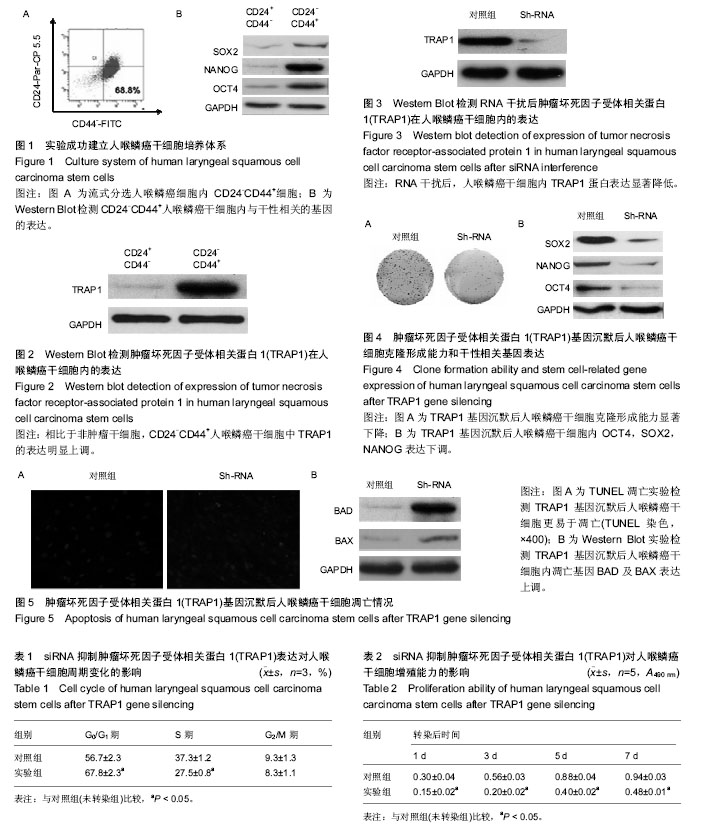| [1] Li L, Xu Y, Wang B. Liriodenine induces the apoptosis of human laryngocarcinoma cells via the upregulation of p53 expression. Oncol Lett. 2015;9:1121-1127.[2] Wang S, J Wu, Song Y, et al. Expression of endothelin-1 in laryngocarcinoma tissues and its clinical significance. Oncol Lett. 2016;11:3366-3368.[3] Zhang W, Li M, Liu N, et al. The application of double pedicle blood supply pectoralis major myocutaneous flap in reconstruction of laryngeal and hypo pharyngeal defect after carcinoma resection. Lin Chung Er Bi Yan Hou Tou Jing Wai Ke Za Zhi. 2015;29:589-592.[4] Feng S, Zhang M, Xu J, et al. Prisconnatanones A, a cytotoxic naphthoquinone from Prismatomeris connata, suppresses the proliferation of human laryngocarcinoma HEp-2 cells in vitro. Nat Prod Res. 2016.[5] 董龙宝,厉倩,徐林根,等.喉鳞癌患者外周血CD45~(low)CD34~+ KDR~+内皮祖细胞的检测及其临床意义[J].中国肿瘤生物治疗杂志,2011,18(3):315-319.[6] 时倩,廉猛,房居高,等.声门上型喉鳞状细胞癌诱导化疗潜在靶向基因的初步分析[J].中华耳鼻咽喉头颈外科杂志,2016,51(7): 504-510.[7] 付莉.喉鳞状细胞癌组织中CD44+、Ki-67+和CD44+/Ki-67-细胞的临床病理学意义[J].兰州大学,2014.[8] 魏静.Smad4在喉癌中的表达及其与淋巴管生成之间的关系[J].哈尔滨医科大学,2014.[9] 李济时.声门上型喉癌的预后及其与BMI1、EZH2表达的相关性研究[D].广州:中山大学,2009.[10] 梁辉.下咽癌FADU细胞系中CD133阳性细胞的基础研究[D].济南:山东大学,2010.[11] 艾毛毛,于锋,黄鑫.顺铂在喉肿瘤细胞转化为干细胞样肿瘤细胞作用的初步探讨[J].临床耳鼻咽喉头颈外科杂志,2015,29(4): 346-351.[12] 黄志刚.喉癌基础研究现状和展望[J].中国耳鼻咽喉头颈外科, 2010,17(2):57-58.[13] 卫旭东,周梁,程磊,等.CD133与喉癌肿瘤干细胞的实验研究[J].中华耳鼻咽喉头颈外科杂志,2007,42(9):692-696.[14] Matsumura S, Ohta T, Yamanouchi K, et al. Activation of estrogen receptor alpha by estradiol and cisplatin induces platinum-resistance in ovarian cancer cells. Cancer Biol Ther. 2016.[15] Diao Y, Azatyan A, Rahman MF, et al. Dahlman-Wright and PG Zaphiropoulos. Blockade of the Hedgehog pathway downregulates estrogen receptor alpha signaling in breast cancer cells. Oncotarget. 2016.[16] 沈培亮,刘兆国,孙丽华.肿瘤治疗新靶点TRAP1研究进展[J].中国药理学通报,2016,32(4):459-463.[17] 周永清,陈旭,丁海斌.胃癌患者中TRAP1、Ki67、AFP的表达及其联合预测胃癌肝转移的价值[J].实用癌症杂志,2016,31(9): 1412-1413.[18] 刘东霞.TRAP1基因沉默和基因过表达对A549细胞和MDA- MB-231细胞信号传导通路影响的研究[D].济南:山东大学,2010.[19] 丁越,张辉,孙晓菊.骨髓间充质干细胞促进皮肤创伤愈合及细胞因子在愈合过程表达研究[J].中国实用口腔科杂志,2015,8(2): 103-107.[20] 向飞.TRAP1对缺氧心肌细胞的保护作用及机制研究[D].重庆:第三军医大学,2010.[21] 周亮,韩兆东,何慧婵.肿瘤坏死因子受体相关因子1蛋白在前列腺癌组织中的表达及意义[J].实用医学杂志,2013,29(19): 3157-3159.[22] 关志,韦春芬,肖晚娇,Med1/TRAP220和uPAR在非小细胞肺癌中表达的临床意义[J].现代生物医学进展,2013,13(18): 3510-3514[23] 曾令花.DDRGK1与端粒酶催化亚基hTERT相互作用的研究.杭州:杭州师范大学, 2015.[24] 段广亮,王凯峰,戴辉萍,等.喉癌干细胞的新型培养纯化方法及临床应用前景[J].浙江临床医学,2016,18(4):602-604.[25] 秦云才,亓玉琴,齐国秀.紫杉醇体外诱导人胃癌细胞凋亡对端粒酶活性影响的研究[J].泰山卫生,2001,25(5):1-3.[26] 王茂鑫,李晓明,赵勇.喉癌干细胞在低氧介导的喉癌放疗抵抗中的作用机制[J].中华耳鼻咽喉头颈外科杂志,2011,46(12): 1024-1029.[27] 黄岸坤,黄少波,廖艳萍.喉部分切除术治疗喉癌的疗效及影响因素分析[J].海南医学,2016,27(12):1965-1967.[28] 王睿,王郡甫,苏庆红.MICA在喉癌组织和细胞中的表达及意义[J].临床耳鼻咽喉头颈外科杂志,2016,30(2):94-97.[29] 韩瑞,皇甫辉,高伟,等.喉癌干细胞在放化疗抵抗中的作用机制[J].临床耳鼻咽喉头颈外科杂志,2014,28(6):400-405.[30] 张嘉萱.肿瘤坏死因子受体相关蛋白1基因(TRAP1)的克隆[S].广东省生物医学工程学会成立30周年纪念大会暨广州,生物医学工程学术大会论文集,2010.[31] Lisanti S, Garlick DS, Bryant KG, et al. Transgenic Expression of the Mitochondrial Chaperone TNFR-associated Protein 1 (TRAP1) Accelerates Prostate Cancer Development. J Biol Chem. 2016;291(48):25247-25254.[32] Liu S, Street TO. 5'-N-ethylcarboxamidoadenosine is not a paralog-specific Hsp90 inhibitor. Protein Sci. 2016;25(12): 2209-2215. [33] Lebedev I, Nemajerova A, Foda ZH, et al. A Novel In Vitro CypD-Mediated p53 Aggregation Assay Suggests a Model for Mitochondrial Permeability Transition by Chaperone Systems. J Mol Biol. 2016;428(20):4154-4167.[34] Sung N, Lee J, Kim JH, et al. 2.4 Å resolution crystal structure of human TRAP1NM, the Hsp90 paralog in the mitochondrial matrix. Acta Crystallogr D Struct Biol. 2016;72(Pt 8):904-911. [35] Palladino G, Notarangelo T, Pannone G, et al. TRAP1 regulates cell cycle and apoptosis in thyroid carcinoma cells. Endocr Relat Cancer. 2016;23(9):699-709. [36] Münch C, Harper JW. Mitochondrial unfolded protein response controls matrix pre-RNA processing and translation. Nature. 2016;534(7609):710-713.[37] Im CN. Past, present, and emerging roles of mitochondrial heat shock protein TRAP1 in the metabolism and regulation of cancer stem cells. Cell Stress Chaperones. 2016;21(4): 553-562. [38] Zhang G, Frederick DT, Wu L, et al. Targeting mitochondrial biogenesis to overcome drug resistance to MAPK inhibitors. J Clin Invest. 2016;126(5):1834-1856. [39] Sung N, Lee J, Kim JH, et al. Mitochondrial Hsp90 is a ligand-activated molecular chaperone coupling ATP binding to dimer closure through a coiled-coil intermediate. Proc Natl Acad Sci U S A. 2016;113(11):2952-2957. [40] Ling Y, Hu Z, Meng Q, et al. Bimatoprost Increases Mechanosensitivity of Trigeminal Ganglion Neurons Innervating the Inner Walls of Rat Anterior Chambers via Activation of TRPA1. Invest Ophthalmol Vis Sci. 2016;57(2): 567-576. |
.jpg)

.jpg)